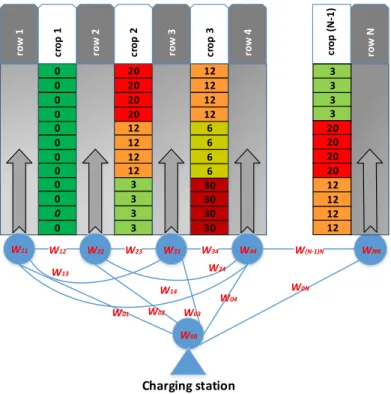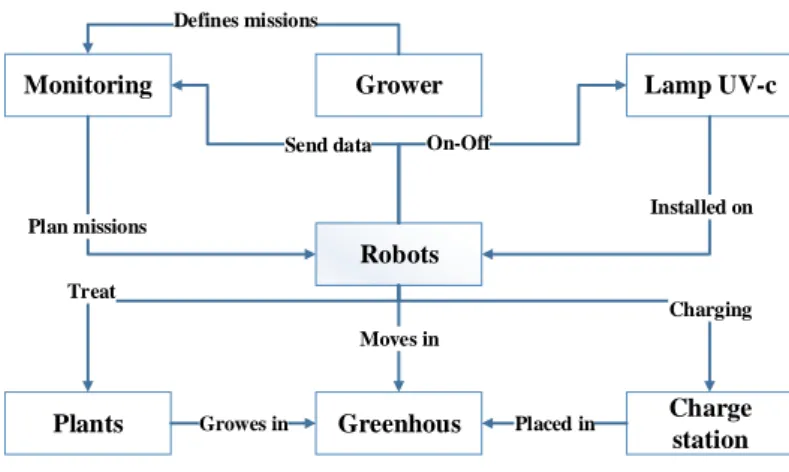Science Arts & Métiers (SAM)
is an open access repository that collects the work of Arts et Métiers Institute of Technology researchers and makes it freely available over the web where possible.
This is an author-deposited version published in: https://sam.ensam.eu
Handle ID: .http://hdl.handle.net/10985/14579
To cite this version :
Merouane MAZAR, M'hammed SAHNOUN, Belgacem BETTAYEB, Nathalie KLEMENT -Optimization of Robotized Tasks for the UV-C Treatment of Diseases in Horticulture - 2018
AFROS2018, TUNIS.
Optimization of Robotized Tasks for the UV-C Treatment of
Diseases in Horticulture
M. MAZAR1, M. SAHNOUN1, B. BETTAYEB1, N. KLEMENT2 1LINEACT (CESI), ROUEN, FRANCE
1LISPEN, ENSAM LILLE, FRANCE
{mmazar, msahnoun, bbettayeb}@cesi.fr, nathalie.klement@ensam.eu
Keywords :Optimization, Simulation, Multi-Agent System, Agricultural Robot, Mildew, Ultraviolet.
1
Introduction
Robots are used in several economic fields such as industry, hospitalization and agriculture. This latter, knows a real revolution concerning the robotization of its tasks because of their painfulness and/or dangerousness for humans as well as the desertion of human worker from the agricultural sector. Several research works interested to agricultural robots, aim to optimize plants treatment against diseases [Oberti et al., 2016] and harvesting [Southall et al., 2002] of crops.
Recent researches in horticulture reveal that the use of type-C ultraviolet (UV-C) treatment against powdery mildew is a sustainable alternative to chemical treatment. The robotization of UV-C treatment in the horticulture field become a necessity due to the hardness of this kind of treatment manually. A new robot (called UV-Robot) is developed to ensure this treatment, while guaranteeing the safety of the human operator against the UV-C radiation. It is able to perform several levels of UV-C treatments by varying its speed when passing behind plants. The robot is wireless and uses a battery that limits the number of plants treated before it needs to be recharged.
The scheduling of UV-Robot tasks represent a real challenge regarding the complexity of the system, the constraint concerning its battery capacity, the procedure of treatment and the dynamic level of diseases.
In this abstract, we study an optimization problem aiming to minimize the necessary number of a robot’s missions during a limited period of time, while ensuring the treatment of all infected plants in the greenhouse. This period must be less than one day (24 hour) [Danan, 2009] to grantee a stationary level of the disease in the greenhouse. A period of treatment contains several missions of at least 30 minutes, depending on the number of plants to be trated and their levels of disease. In fast, the higher is the level of disease, the more is the time of its treatment, which implies a higher power consumption. Each mission is composed of a set of treatment and movement tasks. The robot starts each mission from the charging station and should come back to this station before the exhaustion of its battery. The robot’s battery is recharged during a relatively long time (4 hour in average) between each two successive missions.
In rest of this abstract, we present the mathematical formulation of the optimization problem stated above in section 2. Then, section 3 contains the description of the solving approach that we propose. We end this abstract by summarizing our main contribution and defining the following steps for this work.
2
Problem formulation
As mentioned in the introduction, the problem studied consists of optimizing the robotized treat-ment of plants’ diseases in a greenhouse. Figure 1 shows a representation of the greenhouse and the undirected connected graph corresponding to the robot routing between the charging station and the row corridors. The greenhouse is composed of N − 1 two-sided crops (plants) rows and N rows of dead-end corridors through which the robot passes to treat the plants and return back to the entry
point at the beginning of the row. Each color represents a level of disease that affects the plant. An infected plant should be treated on its both sides facing the two surrounding corridors.
We assume that splitting the treatment is not allowed for individual sides of each plant, neither for the whole plants to be treated in the two sides of the same row corridor, i.e. the robot visits each row corridor at most once.
Let i ∈ {0, 1, .., N} be the index representing the charging station (i = 0) and the row corridors (i ≥ 1). We distinguish two types of tasks for the robot : 1) the treatment of the infected plants in a row corridor and ; 2) the motion between the rows and from the charging station to the rows. Let
wiibe the energy consumption in Wh (Watt-hour) corresponding to the treatment of the ith row and
wij the energy needed to move from row i to row j (i 6= j).
Matrix (1) represents all possible robot’s tasks in the greenhouse. The treatment tasks are placed in the diagonal (wiienergy consumption for the treatment of the row i). In a given mission the robot
goes from a row i to the row j by executing the motion task consuming wij energy.
0 0 0 0 0 0 0 0 0 0 0 0 3 3 3 20 3 12 12 12 12 20 20 20 30 30 30 12 30 6 6 6 6 12 12 12 row 1 row 2 row 3 row 4 cr op 1 cr op 2 cr op 3 W11 W22 W33 W44 WNN W00 W12 W23 W34 W(N-1)N W01 W02 W03 W04 W14 W24 W13 row N cr op ( N -1 ) W0N 12 12 12 12 3 3 3 3 20 20 20 20 Charging station
Figure 1 – Diagram of the greenhouse with the tasks assigned to the robot
W = w00 w01 · · · w0N w10 w11 · · · w1N ... ... ... ... wN 0 wN 1 · · · wN N (1) The objective is to define the optimal treatment and charging schedule, which minimizes the total duration of a treatment. This optimization problem can be formulated as MILP as follows :
minimize Z(Y ) = X k∈K yk (2) Subject to : X j∈N X i∈N wijxkij ≤ Cyk ∀k ∈ K (3) X i∈N xkij = 2 ∀j ∈ N (4)
X j∈N xkij = 2 ∀i ∈ N (5) xk00= 1 ∀k ∈ K (6) X j∈N xk0j = 2 ∀k ∈ K (7) yk≥ yk+1 ∀k ∈ K (8) Where :
— C : Capacity of the battery at the beginning (in Watt) of the mission — wij : Power consumption (in Watt) of the task ij
— xk
ij : a binary decision variable to select tasks
xkii=
(
1 if the robot is treating the row i during the mission k 0 otherwise.
xkij =
(
1 if the robot goes from i to j ∀ i 6= j
0 otherwise.
— yk : a binary decision variable to select the the kth mission
yk=
(
1 if the mission k is planned 0 otherwise.
Equation (2) is the objective function, which correspond to the minimization of the number of missions. The total energy consumption to perform the tasks of each mission k must not exceed the battery’s capacity of the robot (constraint (3)). The two inequalities (4) and (5) express the constraint that the robot should execute a moving task between each two plant treatment tasks, i.e. when two tasks are selected in the diagonal of the matrix (1), the task corresponding to their line-column intersection should be also selected. The robot must start all missions from the charging station, this is expressed by the constraint (6). Constraint (6) means that the robot must return after the end of each mission to the charging station.
This problem as formulated above is equivalent to the one-dimensional bin packing problem. This problem is known to be NP-hard [Bernhard and Vygen, 2008]. This formulation assumes that the dynamic behavior of the diseases in the greenhouse is negligible and one robot is able to treat all the infected plants in a stationary period of time. However, in the case of big instances (bigger or several greenhouses), these assumptions can not be verified. It becomes mandatory to consider the dynamic evolution of the diseases and the possibility to use several robots, which makes the problem much more complex to solve. However, the developed model can be used with in a simulation-optimization approach where the optimization algorithm in run several times during the simulation process. For that, a simulation model is developed, which is presented in the following section.
3
Simulation model
A farm composed of several greenhouses adopting robotized treatment present a high level of system dynamics and interaction between its components. In order to reduce its modeling task, a Multi-Agent System (MAS) model is then proposed. As shown in Figure 2, this system contains seven agents interacting with each other. Each agent’s behavior depends on its own characteristics and the evolution of its environment.
The greenhouse agent is the place that contains the plants, the robot and the charging station. each plant agent grows in the greenhouse and can be treated by the robot. The robot agent treats plants in the greenhouse with UV-C. The charging station agent is installed in the greenhouse and charges of the robot’s battery when it is placed on. The UV-C lamps are a class of agents installed on and controlled by the robot. The monitoring agent schedules missions of the robot and exchanges
Plants Robots Greenhous Charge station Treat Growes in Charging Placed in Moves in Lamp UV-c Monitoring Grower Defines missions Installed on On-Off Send data Plan missions
Figure 2 – Multi agent system model
data with it. The grower agent defines the target of the treatment. The simulator associated to this model is currently being developed using NelLogo Software.
4
Conclusion
In this abstract, we explained a plant treatment system in horticulture, which represents a complex system because it is composed of several interacting entities. Two models are presented : the first is MILP optimization model equivalent to the bin packing problem, and the second is MAS based simulation model. We will implement our two models in a simulator able to simulate and optimize the process of UV-C robotized treatment. the first trials of the simulation will be done on relatively small instances to tune and validate the approach. After, the simulation prototype will be implemented in several real cases, using the robot developed by Octinium (a project partner), to prove the effectiveness of this innovative solution.
Acknowledgment
This research was made possible thanks to €1.35 million financial support from the European Regional Development Fund provided by the Interreg North-West Europe Programme in context of UV-ROBOT
Références
[Bernhard and Vygen, 2008] Bernhard, K. and Vygen, J. (2008). Combinatorial optimization : Theory and algorithms. Springer, Third Edition, 2005.
[Danan, 2009] Danan, S. (2009). Diversité structurale des locus de résistance à phytophthora infestans chez la pomme de terre et synténie chez les solanacées. Diversité structurale des locus de résistance à
Phytophthora infestans chez la pomme de terre et synténie chez les Solanacées, Centre International
d’Etudes Supérieures Agronomiques (2009).
[Oberti et al., 2016] Oberti, R., Marchi, M., Tirelli, P., Calcante, A., Iriti, M., Tona, E., Hočevar, M., Baur, J., Pfaff, J., Schütz, C., et al. (2016). Selective spraying of grapevines for disease control using a modular agricultural robot. Biosystems Engineering, 146 :203–215.
[Southall et al., 2002] Southall, B., Hague, T., Marchant, J. A., and Buxton, B. F. (2002). An au-tonomous crop treatment robot : Part i. a kalman filter model for localization and crop/weed classification. The international journal of robotics research, 21(1) :61–74.

